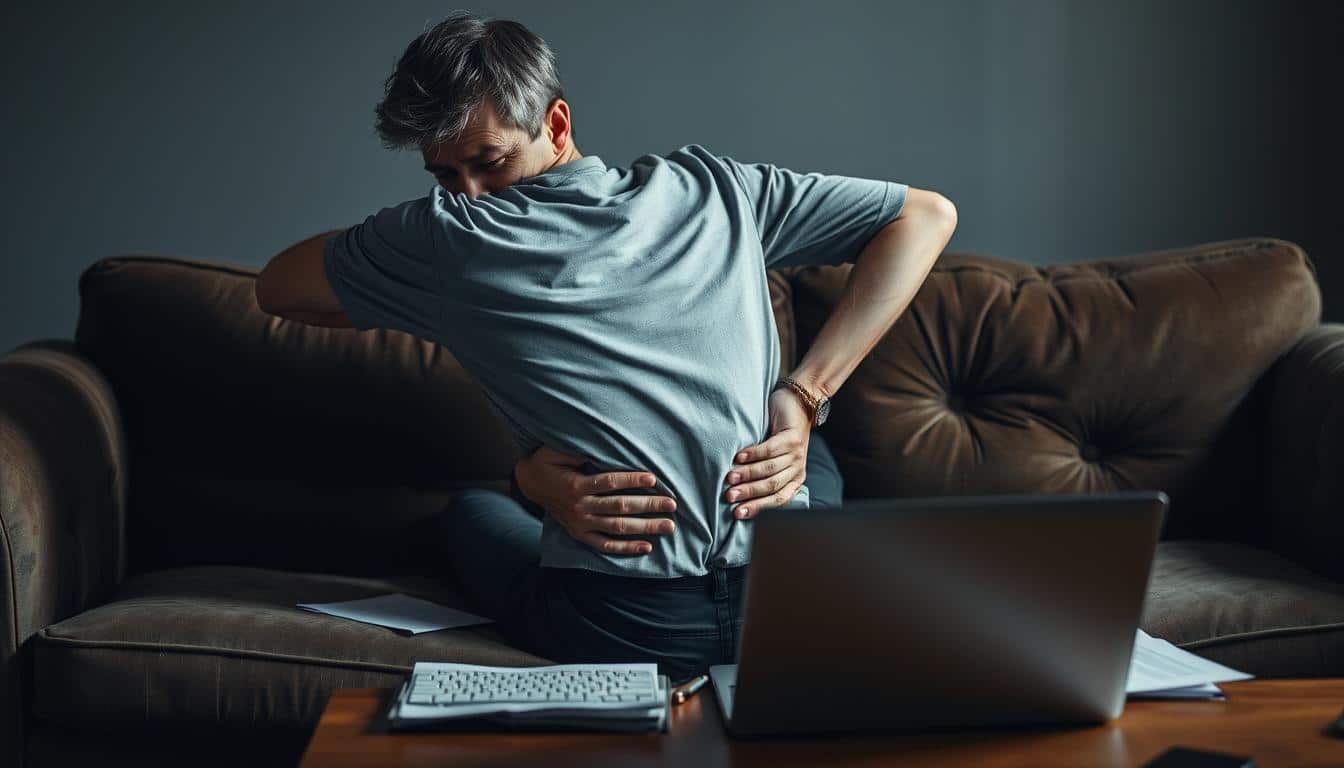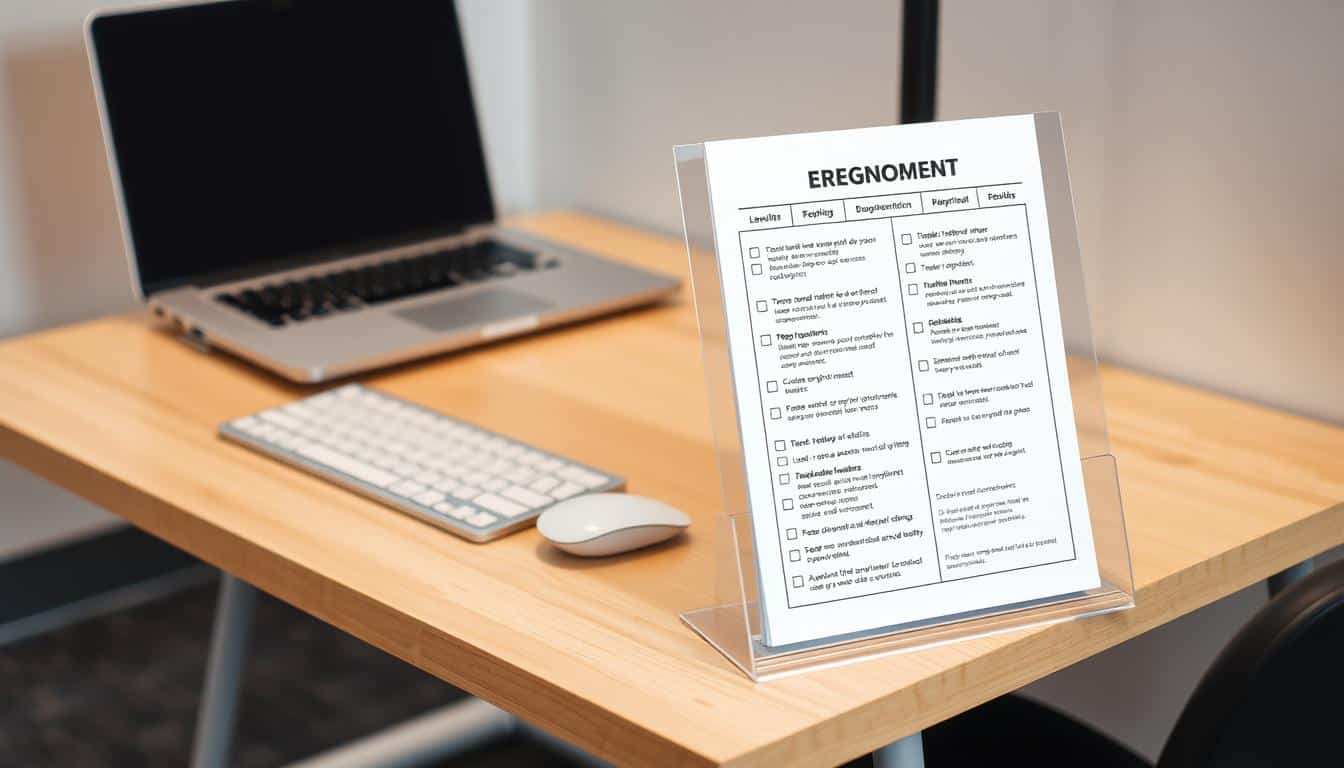Back pain is very common for many working adults. This is especially true for those without a proper office chair. Learning about back pain and finding ways to fix it is important. This article talks about ways to reduce back pain for a better work setting. It focuses on ergonomic strategies that help. These methods aim to fix the main reasons for pain and teach better posture. By doing so, readers can lessen their pain and work better.
Understanding Back Pain and Its Causes
Back pain is a big problem for many adults today. Almost two-thirds of adults feel this kind of pain at some point. Lower back pain is very common, especially in office workers. Between 31% and 51% of them deal with it regularly. It’s more frequent in people under 45, showing we need to tackle this work-related problem soon.
The Prevalence of Back Pain in Adults
Back pain has become a big issue for a lot of adults. Many find themselves going to the doctor because of it. It causes not just physical pain, but can also make life harder and reduce how much work gets done.
Common Causes of Back Pain at Work
It’s important to know why back pain happens to avoid and treat it. At work, back pain often comes from a few key reasons:
- Prolonged sitting during office hours
- Poor workstation ergonomics
- Incorrect posture while using computers
- Repetitive strain from manual tasks
These issues can cause discomfort now and more serious problems later if not taken care of.

Impact of Prolonged Sitting on Back Pain
Sitting for too long plays a big part in back pain problems. Many people spend a lot of time at a computer and forget how they are sitting. This can cause your muscles to tense up and feel sore. It’s really important to look at how we sit. Especially when our work area isn’t set up right for our bodies.
Sitting Posture and Its Effects
When we sit the wrong way, our back muscles can get really tight. Doing things like slouching or leaning too much puts extra pressure on our lower back. Over time, this can lead to back issues. These bad habits can make us feel stiff and uncomfortable.
The Role of Muscle Tension in Back Pain
Staying still for too long can make our muscles tight, causing back pain. This stiffness happens because we’re not moving enough. To fix this, moving around and stretching each day is important. By making our workspaces better for our bodies, we can reduce pain. This also helps us work better and feel good.
Importance of Ergonomics to Prevent Back Pain
Creating an ergonomic workspace helps reduce back pain. It’s about making your work area fit your body’s needs. This can ease discomfort and boost health. A key part of this is setting your desk height right. It should match your seated elbow level to keep you comfy all day.
Creating an Ergonomic Workspace
To avoid back pain, your workspace must minimize odd postures. Key elements include:
- Adjustable desks and chairs for different body sizes.
- Chairs that support the back’s curve well.
- Tools and materials should be easy to reach, so you don’t strain.
Adding these features can make you more productive and comfortable at work.
Proper Desk Height and Chair Support
Desk height and chair support are big factors in avoiding back pain. Your desk should let your elbows bend at 90 degrees when sitting. Chair support is equally important. It should back up the spine’s curve well. When both are right, they lower back pressure. This makes work much more comfy.
Back Pain from No Office Chair: Risks of Improper Seating
Using the wrong seat, like stools or shaky chairs, can hurt your back. These seats don’t support your body the right way. This makes you sit in bad positions, putting too much pressure on your spine. Knowing the dangers of these seats is vital. It helps make a healthier place to work.
Effects of Improvised Seating Options
The problems with these seats show up after a while. Users often feel uncomfortable. Common issues are:
- Increased muscle tension in the lower back
- Reduced blood circulation in the legs
- An elevated chance of spinal misalignment
- Heightened risk of developing chronic back pain
How Incorrect Support Leads to Discomfort
Chairs that don’t support the lower back lead to trouble. This makes the spine rest in bad positions, causing pain. A good office chair keeps your posture right. Pick ergonomically designed chairs to avoid back pain. Looking for the right chair keeps you comfy and healthy in the long run.
Effective Stretches for Alleviating Back Pain
Stretching is key for those stuck at a desk all day. It helps your posture, makes you more flexible, and eases muscle tightness. Doing stretches meant for desk workers can make a big difference during your day.
Benefits of Stretching Throughout the Day
Stretching every day is good for your body. It makes you more flexible and stops muscles from getting stiff. It also helps blood flow and reduces stress.
- Improves overall flexibility and range of motion.
- Reduces the likelihood of muscle stiffness and strain.
- Enhances circulation, promoting nutrient delivery to muscles.
- Supports mental well-being by alleviating stress.
Top 5 Stretches for Desk Workers
Here are five stretches that help with back pain for those at desks:
- Chest Opener: Stand tall, interlace your fingers behind your back, and gently pull your shoulders back for a deep stretch across the chest.
- Neck Rotation: Sit or stand comfortably and slowly rotate your head from side to side to ease neck tension.
- Upper Body Stretch: Reach both hands overhead while standing and lean slightly to one side, then the other.
- Trunk Rotation: While seated, place your right hand on the back of your chair and twist your torso gently, followed by the left side.
- Hamstring Stretch: Stand and extend one leg out straight while bending forward at the hips to reach for your toes, alternating legs.
Building Core Strength to Support the Spine
Making your core strong is key to keeping your spine supported and stable. A strong core helps spread your weight evenly, stopping problems caused by bad posture. Adding exercises that support your spine into your day can cut down on back pain.
Importance of Strong Core Muscles
Core strength is super important for your spine. When your core muscles are strong, they keep your spine aligned and lower the chance of getting hurt. If these muscles are weak, your spine gets stressed, which can lead to pain.
Simple Exercises to Do at Your Desk
There are simple exercises you can do right at your desk to build your core. Try these:
- Seated Leg Lifts: While sitting, extend one leg out straight and hold for a few seconds before lowering. Repeat with the other leg.
- Chair Bridges: While seated, press your feet into the floor and lift your hips slightly off the chair, engaging your core.
- Seated Torso Twist: Sit upright and gently twist your torso to one side, holding for a moment, then switch sides.
Doing these exercises at work can boost your core strength and lessen the harm from sitting too long. With strong core muscles, your posture improves and you feel better overall.
Tips for Maintaining Good Posture at Work
Keeping a good posture helps reduce back pain and makes you more comfortable at work. Good posture habits can really improve your day. Focus on keeping your spine neutral, meaning it has its natural curves. This reduces the pressure on your muscles and ligaments.
How to Keep a Neutral Spine
For a neutral spine, start with your feet flat on the ground. Your knees should be at a 90-degree angle, with your hips a bit higher. This helps you sit up straight. Make sure your chair fully supports your back. This way, it aligns your spine correctly. Changing how you sit during the day can also reduce soreness.
Correct Positioning of Equipment
Putting your equipment in the right spot is key for good posture. Your monitor should be at eye level to avoid neck pain. Keep your keyboard close so your arms can relax by your side. Following these tips and setting up your equipment properly makes for a healthier work setting. It also helps keep your spine aligned.
Lifestyle Changes to Manage Back Pain
Lifestyle choices are key in handling and preventing back pain. Tweaking some habits can majorly boost spine health. Getting active and eating right are big steps for dealing with back pain.
Incorporating Regular Physical Activity
Regular physical activity brings lots of benefits. It strengthens your core and back and increases flexibility to avoid injuries. Adding simple exercises like walking, swimming, or biking to your day is easy.
- Walking for 30 minutes a day boosts blood flow.
- Yoga makes you more flexible and less stressed, cutting back pain.
- Strength training builds strong muscles around your spine.
The Role of a Healthy Diet in Back Pain Management
Eating well is crucial for back pain because it gives your body the nutrients it needs for strong muscles and bones. Foods that fight inflammation can ease discomfort and make you feel better. Try to eat:
- Antioxidant-packed fruits and veggies.
- Whole grains for energy and longer-lasting physical activity.
- Lean proteins for muscle repair and growth.
Adopting these lifestyle changes can really help with back pain. They lead to a healthier, pain-free life.
When to Seek Professional Help for Back Pain
Living with back pain every day is hard. Knowing when to get professional advice is key for good care. Signs like severe discomfort, numbness, and weakness mean it’s time to see an expert.
Signs It’s Time to Consult a Chiropractor
Here are reasons you might need to see a chiropractor:
- Severe pain that doesn’t improve with home remedies.
- Numbness or tingling in the arms or legs.
- Weakness in the extremities.
- Pain that radiates down the legs or arms.
A chiropractor can adjust your spine. This can ease nerve pressure, helping with pain and making you move better.
Benefits of Physical Therapy for Back Pain Relief
Physical therapy helps ease back pain by focusing on function and easing pain. It offers:
- Customized exercise plans to strengthen supporting muscles.
- Techniques to improve flexibility and posture.
- Education on proper body mechanics to prevent future issues.
Starting physical therapy early can lower the risk of long-term pain and speed up recovery.
Conclusion
To deal with back pain effectively, especially without normal office chairs, needs a full plan. Knowing why back pain happens and using the right ergonomic methods is key to feeling better. Making small changes in how you sit, organize your desk, and move can help relieve pain.
Also, doing stretches and exercises to make your back stronger can greatly help with back pain. The tips provided here are easy to follow in your daily life, leading to long-lasting benefits. By taking action now, you can improve your comfort and ability to do everyday tasks.
Putting in the time and effort to follow these steps can do more than reduce back pain. It can make your overall life better. People who make these changes often find lasting comfort and do their daily activities more easily.



